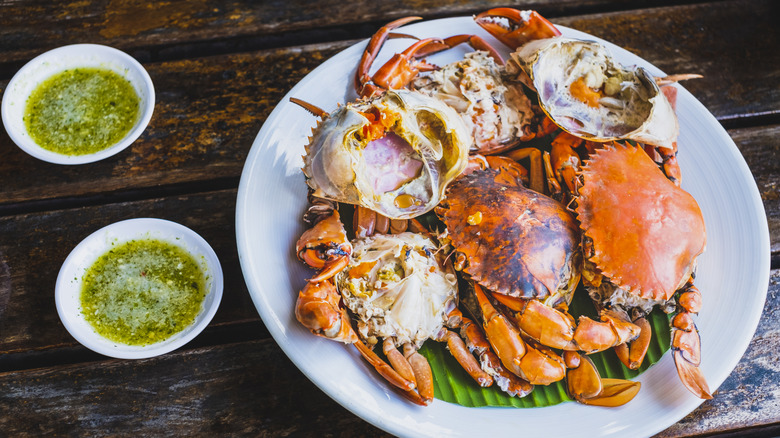Can You Substitute Different Kinds Of Crabs Across Recipes?
Crab is one of the sea's most delicious offerings, and making it in your own kitchen can be as easy as opening a can, or as challenging as cracking the whole crustacean open with an actual mallet. There are also abundant varieties, like the mightily sized (and appropriately named) king crab, the more petite Dungeness crab, and the ubiquitous snow crab. This is also to say nothing of the best uses for all of a crab's studiously harvested meat, or what the soft shell's whole deal is, again. So we tapped Katie Lee Biegel, the culinary curator at FultonFishMarket.com to claw out some exclusive answers.
First of all, hard and soft crabs are as diametrically opposed as they sound. "The type of crab meat you use makes a difference all the way around," Lee Biegel says. "Soft-shell crabs are a whole different experience — those you cook and eat whole, and they're delicious fried. For recipes using the meat, whether you go with lump, claw, or leg meat changes how delicate or bold your final dish will taste, and the texture." So, if that crab cake recipe explicitly calls for lump meat, for example, that's really what you should use for the best results. And Lee Biegel's additional description of a crab's disparate parts make it a little easier to remember what you'll probably want to use when.
Stars and supporting characters: casting your crab for the best success
Just like you'd definitely want to serve an expensive cut of beef like a chateaubriand or a filet mignon mostly unadorned, but use a cheaper skirt or flank steak tucked into something like tasty tacos, so, too, do crab parts have their optimal applications. "Jumbo lump crab is the most luxurious of crab — big, sweet pieces that look gorgeous in something like a crab cocktail or a showstopper crab cake," Katie Lee Biegel says. "Claw and leg meat are darker and a bit stronger in flavor, and I actually love them for soups or crab pasta because they hold their own."
So turn to lumps when you really want to spotlight that beautiful seafood, and count on claws and legs when crab is an ingredient, rather than the main event. And, on those occasions when you just happen to be working with whatever crab you're working with, it can be cautiously forgiving. "You can substitute, but the feel of the dish changes," Lee Biegel says. When you're going to all the trouble of cooking a delicious meal, we wouldn't expect anyone to get too crabby about it.

